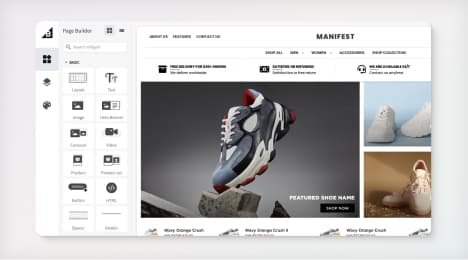
Watch Our Product Tour
See how BigCommerce helps you build and manage your online store with ease.
- Ecommerce Insights

6 Key Steps to Launch Your Online Store
Explore our Launch Foundations series to get your BigCommerce store up and running quickly.
BigCommerce helps growing businesses, enterprise brands, and everything in-between sell more online.
Understanding the big changes at FedEx and UPS for shippers
Unless an ecommerce store is using drop shipping or partnering with another organization to provide shipping services, either the store owner or a helper is packaging and sending out orders from customers. Shipping is a fact of life for ecommerce retailers and shoppers alike, and the costs of shipping can be enough to encourage customers to use a different store instead of the one where they've almost completed a purchase. Keeping shipping costs down is important because it helps attract and retain customers, and because high shipping costs can cut into the revenue of a store owner.
Businesses that are shipping to customers across the U.S. or to other countries are likely using FedEx, UPS or both companies, along with the U.S. Postal Service in some instances. The two private carriers have recently announced a major change to the way they formulate the shipping costs for the vast majority of items, called dimensional pricing. More than just a rate increase for service, the switch by FedEx and UPS is a change in the way those businesses place a cost on parcels and how they assess internal costs. The rise of ecommerce has altered the approach that the two major U.S. carriers are taking to delivery.
The back story
As UPS and FedEx grew into their current status as multinational giants through the 1970s and 1980s, there wasn't an ecommerce component to business. People certainly bought items from catalogs through mail and over the phone, and those businesses often used the major carriers to ship out orders. However, the selection was still relatively limited and the volume of those orders wasn't nearly as high as it is for ecommerce purchases. The major cost consideration for UPS and FedEx when it came to packages was weight. Weight was, and still is, important in terms of the cost to deliver a package. The weight of packages affects the gas mileage of the delivery trucks, and of the tractor-trailers and airplanes that bring large amounts of packages to the facility where they're placed on the truck for final delivery.
The amount of packages handled by the major carriers has grown significantly as ecommerce has become a bigger part of the economic picture. Because UPS and FedEx weren't charging extra for the volume of a package, many businesses were using boxes that were larger than absolutely necessary and including extra filling material - such as bubble wrap or packing peanuts - to make sure products arrived undamaged.
Both carriers recently decided that, due to the large increase in the total amount of packages they handle, that they had to account for the volume of packages on their delivery trucks and throughout their transportation infrastructure. The two businesses realized that larger packages meant fewer deliveries per truck, and therefore reduced profits. The cost of delivery for packages now takes into account both weight and volume, hence the term used - dimensional shipping.
What does it mean for an ecommerce business?
For new stores and those about to start up, there may not be an immediate sign of the switchover to dimensional shipping. Both UPS and FedEx will switch over to the pricing structure by the beginning of 2015, however. Here's a look at how these two companies will apply the charges:
FedEx
All ground shipments will use dimensional weight pricing, according to the company. FedEx had previously only applied the charge, which it defines as the space a package occupies in relation to its weight, to items larger than three cubic feet in size being shipped by ground. FedEx Air service already uses dimensional pricing.
UPS
UPS will start pricing all of its ground shipments using dimensional weight on Dec. 29, 2014. UPS is using the same criteria for calculating dimensional prices, and noted that it had previously used the calculation method for other areas of operation.
How can businesses combat increased charges?
Dimensional shipping costs will mean that large but light packages will cost more to send out than they did previously. Ecommerce store owners can take some simple, effective steps to combat these increased charges, some of which are easier to make for businesses just starting out. The simplest, and likely the most effective, is to be conscious of package size and use smaller boxes when possible. The smaller the package, the lower the cost incurred. There needs to be room for filler to protect the contents as appropriate, but this can often be achieved with smaller boxes.
Providing the exact dimensions of the box to a carrier, instead of estimating, can also help save money - every fraction of an inch counts. This approach is easier with standardized packaging sizes, an approach that new ecommerce store owners should consider to make the order fulfillment process easier in general.
Although dimensional shipping charges mean a new approach from the major carriers to pricing, it doesn't mean that ecommerce businesses have to start paying significantly more. Making a few adjustments to package size can help keep those costs in control.
BigCommerce helps growing businesses, enterprise brands, and everything in-between sell more online.
Start growing your ecommerce business even faster.
High-volume or established business? Request a demo